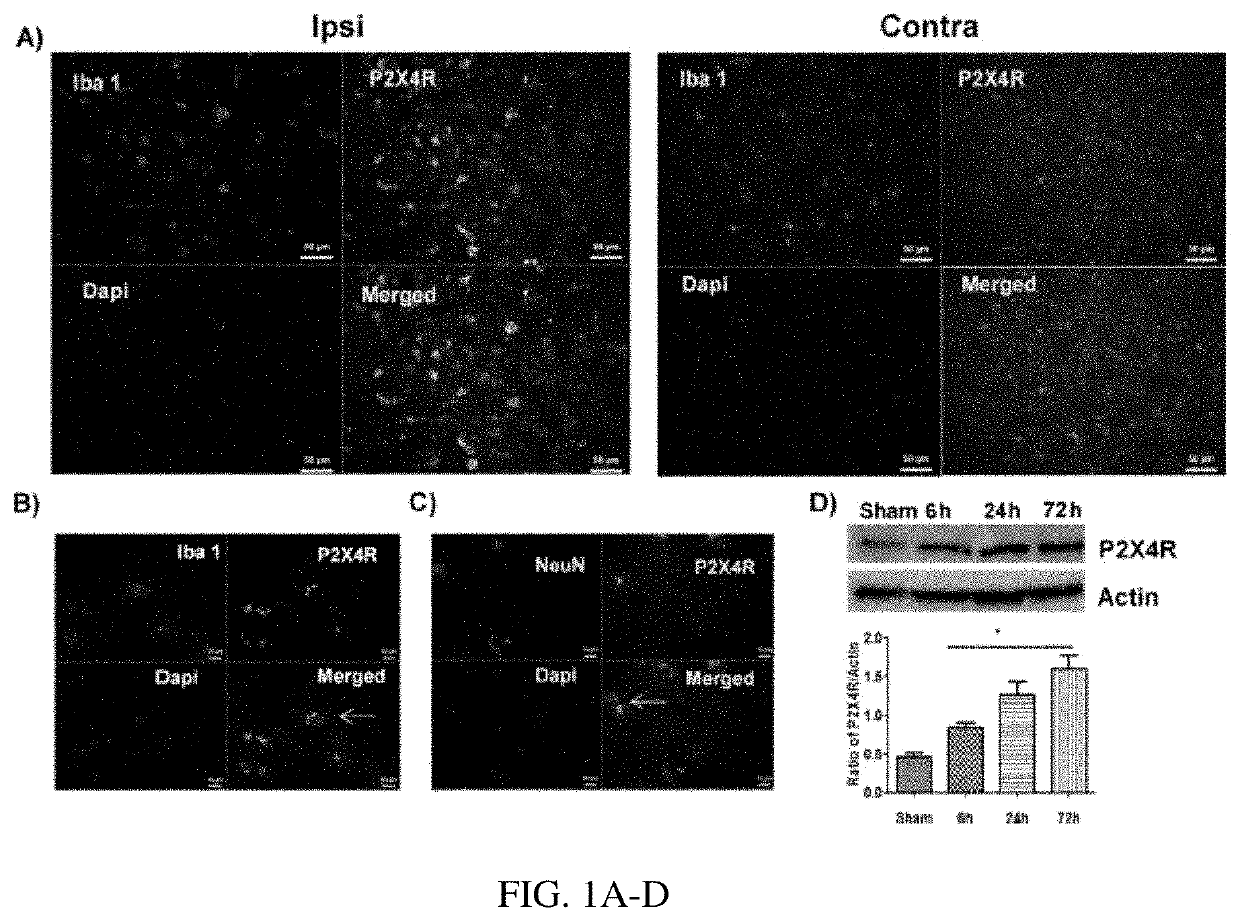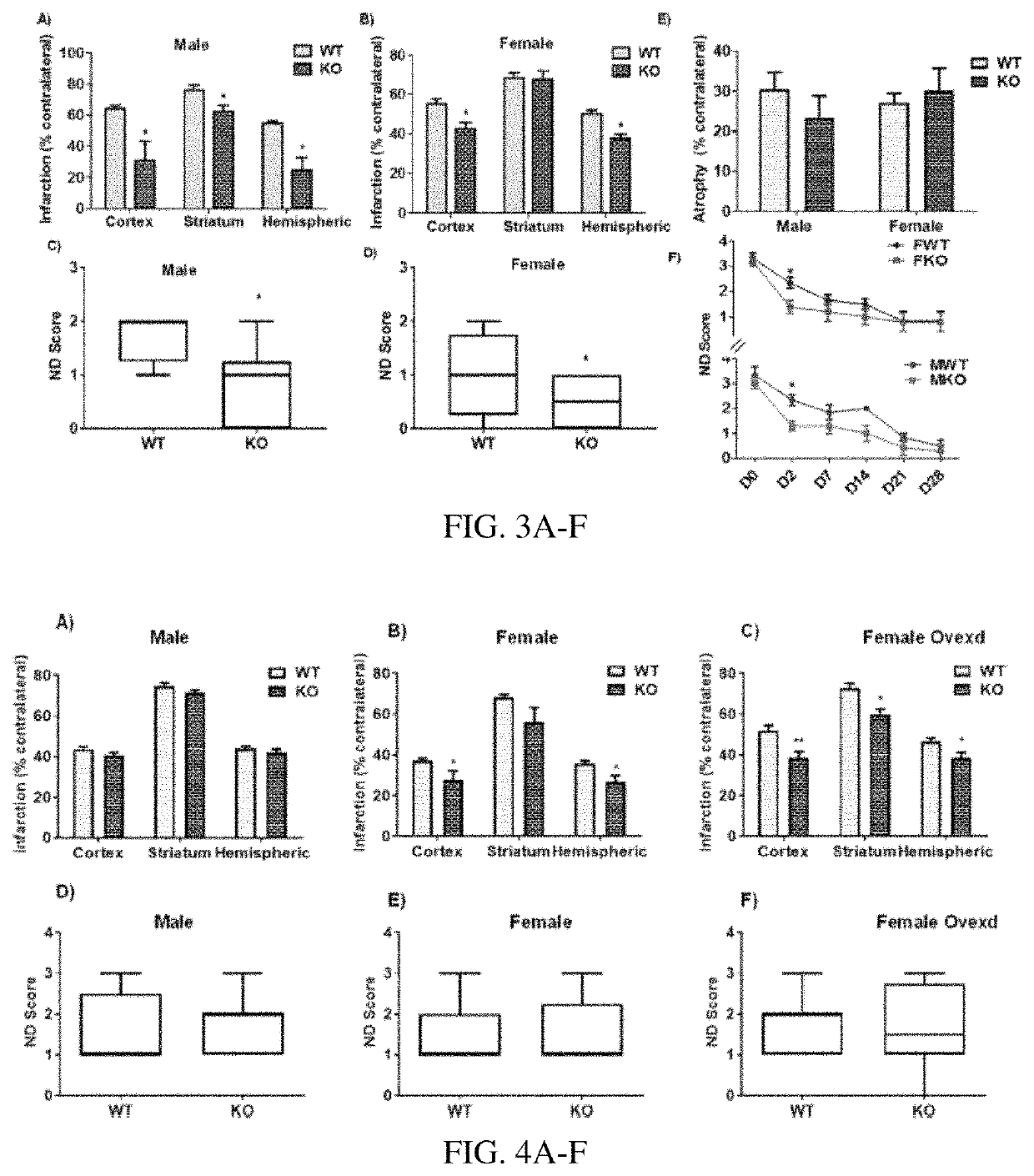Methods for pharmacologic treatment of stroke
a pharmacologic treatment and stroke technology, applied in the field of stroke treatment, can solve the problems of missed work days, cost of health care services, and current approaches to treating ischemic stroke are primarily limited, and the risk of bleeding is high
- Summary
- Abstract
- Description
- Claims
- Application Information
AI Technical Summary
Benefits of technology
Problems solved by technology
Method used
Image
Examples
example 1
ression Increases after Stroke
[0094]Three days after stroke, P2X4R expression increased in the perilesional cortical region of the ischemic hemisphere in male WT mice (FIG. 1A). Using co-localization studies, we found that the P2X4R expression was primarily on microglial cells (Iba1+; FIG. 1A, B) and to a lesser extent on neuronal cells (NeuN+, FIG. 1C). Confirming the immunohistochemistry data, Western blot analysis showed a progressive increase in P2X4R expression over the first three days after stroke as compared to sham (FIG. 1D).
example 2
d MS P2X4R KO Show Changes in Microglial Morphology after Stroke
[0095]In addition to the high expression of P2X4R in microglial cells, co-labeling with Iba-1 revealed an increase in microglial activation (based on morphological changes) in WT male mice after three days of stroke in the perilesional cortex of the ipsilateral hemisphere. While the WT mice showed an amoeboid or round morphology characteristic of a highly activated state, both the global and MS P2X4R KO mice showed shorter processes, less arborization, and larger soma, indicating an intermediate activation state (FIGS. 2A and B). These data suggest that P2X4Rs are involved in microglia / macrophage cell activation.
example 3
X4R KO Mice Show Acute Neuroprotection
[0096]We next examined post-stroke recovery at an acute time point after stroke (day 3). We found that both male and female P2X4R global KO mice showed significant neuroprotection at this time point. Specifically, male mice showed a reduction in cortical, striatal, and total hemispheric infarct volume compared to WT littermates (FIG. 3A); female mice displayed a similar reduction in cortical and total hemispheric infarct volume but not in striatal infarct volume (FIG. 3B). Behaviorally, both sexes showed improvements in the ND score compared to control mice (FIG. 3C, D), indicating acute post-stroke behavioral benefits. In contrast to the acute time point, we did not see any changes in tissue atrophy (FIG. 3E) or ND scores (FIG. 3F) between male or female global KO and WT mice at a chronic stage of stroke (day 30), suggesting that the acute benefits in the KO mice were lost during progressive recovery.
PUM
| Property | Measurement | Unit |
|---|---|---|
| temperature | aaaaa | aaaaa |
| time period | aaaaa | aaaaa |
| time | aaaaa | aaaaa |
Abstract
Description
Claims
Application Information
 Login to View More
Login to View More - R&D
- Intellectual Property
- Life Sciences
- Materials
- Tech Scout
- Unparalleled Data Quality
- Higher Quality Content
- 60% Fewer Hallucinations
Browse by: Latest US Patents, China's latest patents, Technical Efficacy Thesaurus, Application Domain, Technology Topic, Popular Technical Reports.
© 2025 PatSnap. All rights reserved.Legal|Privacy policy|Modern Slavery Act Transparency Statement|Sitemap|About US| Contact US: help@patsnap.com



